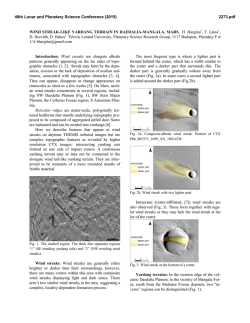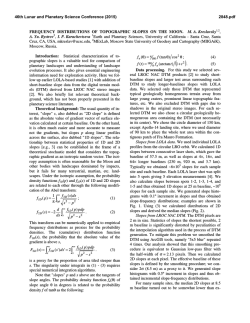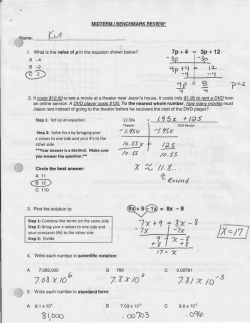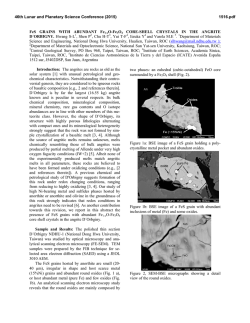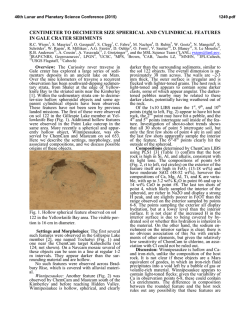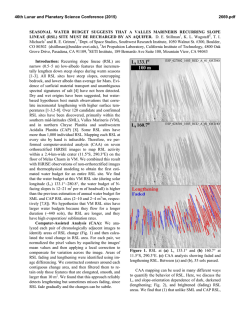
SLOPE STREAKS ON MARS: ANALYSIS OF GEOMETRIC
46th Lunar and Planetary Science Conference (2015) 1115.pdf SLOPE STREAKS ON MARS: ANALYSIS OF GEOMETRIC PARAMETERS. E. S. Brusnikin1, M. A. Kreslavsky1,2, I. P. Karachevtseva1, A. E. Zubarev1, V. D. Patratiy1, and J. W. Head3 1MIIGAiK Extraterrestrial Laboratory, Moscow State University of Geodesy and Cartography (MIIGAiK), Moscow, Russia ([email protected]), 2Earth and Planetary Sciences, University of California - Santa Cruz, Santa Cruz, CA, USA ([email protected]), 3Department of Geological, Environmental and Planetary Sciences, Brown University, Providence, RI, USA. Introduction: Slope streaks [e.g., 1] are a unique active phenomenon on Mars; they differ from so-called recurring slope lineae [2] in their morphology, settings and mode of occurrence. The mechanism of slope streak formation is not known, but there are two main hypotheses for their origin: "dry", a specific kind of dust avalanche that has never been observed in terrestrial and laboratory environments [1], and "wet", a specific kind of percolation of brines in the shallow subsurface [3]. Slope streaks are formed in equatorial regions with relatively steep slopes and high concentrations of dust, which makes landing and roving on them difficult. Therefore, we use remote sensing data to assess the geometric characteristics of slope streaks to distinguish between these two main types of hypotheses for their origin. Observations: For our study we use stereo pairs of images obtained by the High Resolution Imaging Science Experiment (HIRISE) onboard MRO. For each raw image, parameters of internal and external orientation were computed using SPICE kernels, which enabled photogrammetric measurements [4]. Then, all measurements were carried out by means of the Photomod software complex [5], which makes possible 2D and 3D visualization of measured features. Measurement results then were exported to ESRI ArcGIS [6] and analyzed using its capabilities. The use of Photomod allows rapid and accurate manual photogrammetric measurements of slopes without the timeconsuming generation of digital terrain models. The implicit precision of manual parallax measurements by an experienced operator with high-quality HiRISE images is better than one pixel, which, depending on stereo geometry, typically yields about ~0.5m (1 m) vertical precision for full-resolution (2x reduced-resolution) images. This precision provides slope measurement accuracy of ~2º (~4º) for short ~20 m segments, and proportionally better accuracy for longer segments. We measured the geometric parameters of the streaks: 1) proximal locations where the streak beginnings, 2) lengths, 3) azimuths, 4) slopes along the streaks, and 5) distal locations of streak terminations. We paid special attention to the proximal (initial uppermost) segments of the streaks because they should bear information about streak triggering mechanisms. We also paid special attention to streaks observed on gentle slopes and searched for any examples of streak segments propagating uphill. We also measured slopes where slope streaks do not form. In our survey thus far, we have processed 4 stereo pairs, registered over 300 streaks and measured slopes of over 2000 streak segments; selected examples of slope measurement results are shown in Figs. 1 - 3. Fig. 1. Example of measurements of slope streak geometric parameters on a HIRISE stereo pair (PSP_001656 and PSP_002632_2175). Negative slopes mean downhill direction. Distal parts of streaks often have very gentle slopes. Fig. 2. A slope streak crossing a crater (images ESP_017585_2080 and ESP_025734_2080). There is no uphill segment of the streak in this case. 46th Lunar and Planetary Science Conference (2015) Fig. 3. Example of the measurements of streaks on low slopes (images ESP_037351_2125 and ESP_037206_2125). Results: The length of the streaks varies from several meters to hundreds of meters. The streaks can abruptly change their direction in case of an increasing slope angle or change in slope direction. Distal (lowermost) parts of streaks often do not have clear boundaries when observed at the highest possible resolution (Fig. 3). Branching is often observed in these parts. Streaks always end on a slope gentler than at their beginning. The median slope of all measured segments is 24.3º, while the median slope of the initial (proximal) part is steeper, 27.8º. At least partly this reflects the general concave profiles of streak-bearing slopes. Typi- 1115.pdf cally, streaks begin at steep slopes; the lowest streak beginning we found so far is ~17º and a few more streaks begin at ~20º slopes (Fig. 3A). Some streaks run long distances on gentle slopes. For example, sections B and C together of the streak in Fig. 3 is ~310 m long and have an average slope of 10.7º. The distal parts of streaks are also often on very gentle slopes (Fig. 1). Our survey yielded a few distal streak segments that are horizontal close to their ends (Fig. 3D) or even appear to go a few degrees uphill; however, all such segments are very short, therefore the slope measurement accuracy is low. To date, we have not found any reliable example of a streak propagating uphill. For example, in Fig. 2 the streak that appears to be "climbing" out of a crater is actually propagating downhill all the way. Discussion. The observations that the streaks turn in direction, follow the slope, and seem not to propagate uphill are consistent with earlier conclusions [7] that the streak-forming process is not associated with appreciable inertia. The observed propagation of slope streaks for long distances on gentle slopes (Fig. 3) is very difficult to reconcile with any dry granular flow model. For example, turning direction from segment B to segment C in Fig 3, a putative dust avalanche would lose all its momentum; then it should regain it on a slope as gentle as 8º. The typical dynamic angle of repose for dry granular materials is much steeper than this, even if lower gravity is taken into account [8]. Thus, a "dry" formation mechanism for this example would require very unusual microphysics for dust avalanches that would necessarily dramatically decrease the dynamic angle of repose. On the other hand, the observations that the streaks always begin on steep slopes, while they can also propagate long distances on gentle slopes, is puzzling. In the context of the "wet" mechanism [3] it would seem more probable that that steaks could be triggered an any slope on which they can propagate. Initiation only on slopes steeper than the dynamic angle of repose is natural prediction for a "dry" mechanism, but then continuing on gentle slope is difficult to explain by this same mechanism. It is possible that streaks initiation on gentle slopes is rare; we have not yet encountered such an example. Acknowledgments: This work was carried out in MIIGAiK and supported by Russian Science Foundation, project 14-22-00197. References: [1] Sullivan R. et al. (2001) JGR 106, 23,607. [2] McEwen A. et al. (2011) Science 333, 740. [3] Kreslavsky M.. and Head J. (2009) Icarus 201, 517. [4] Zubarev A. and Nadezhdina I. (2013) ISPRS Meeting of the Working Group IV/8. [5] http://www.racurs.ru/. [6] http://www.arcgis.com. [7] Miyamoto H. et al. (2004) JGR 109, E06008. [8] Kleinhans M. et al. (2011) JGR 116, E11004.
© Copyright 2024
